![]()
![]()
![]()
Use LEFT and RIGHT arrow keys to navigate between flashcards;
Use UP and DOWN arrow keys to flip the card;
H to show hint;
A reads text to speech;
18 Cards in this Set
- Front
- Back
|
Apulu, Etruscan, 500 BCE
was on top of a temple same time as Greek Kouros, but not concerned with form, more with movement and much more about gesture than body |
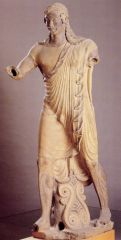
|
|
|
Aule Metele, Etruscan, 50 BCE
practically fully roman, only etruscan in the name roman dress, etc. Even while romans were conquering, Etruscans still making great metal work. Etruscan didn't die out, just turned into Roman Art |
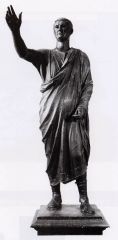
|
|
|
Banditaccia Necropolis, Etruscan, 600-100 BCE
funerary complex, looked like Greek tholos tombs, mounds, beehive-like, called tomolus tombs often clustered together organized, showed an interest in honoring dead |

|
|
|
Tomb of the Leopards, Etruscan, 500 BCE
Banqueters mural, shows a typical banquet style=simple, stylized, outlined, patterned ceiling like the minoans, narrative Everyday scene, even has some of workers behind the scenes. FULL narrative not as naturalistic in terms of human form, but etruscan depiction of nature is very good |

|
|
|
Capitoline Wolf, Etruscan, 500 BCE
(babies werent on original) shows story of wolf who nursed romulus and reamus, founders of rome, breasts are FILLED with milk, nurturing, giving life, even though she looks emaciated...Sacrifice she is grounded and protective, using all of her strength |
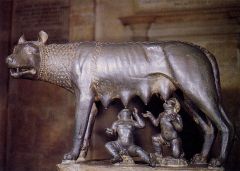
|
|
|
Chimera of Arezzo, Etruscan, 350 BCE
composite creature, bronze, was a votive offering wounded just like in greek mythology, but refuses to surrender muscles strained, thin, just like capitoline wolf prepared to attack |
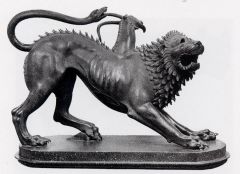
|
|
|
Tomb of hunting and Fishing, Etruscan, 500 BCE
Shows young men enjoying birds and swimming, enjoying the afterlife, reminiscent of Egyptian tombs, perhaps had some knowledge, Greeks emulated this fresco |
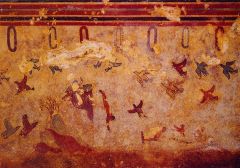
|
|
|
Model of an Etruscan temple, 550 BCE, Etruscan
like a greek temple, but deeper portico, stairs protrude from center, lots of columns, wood roof (lighter), no pediment, had decoration on top of roof, made out of wood and brick, no marble |
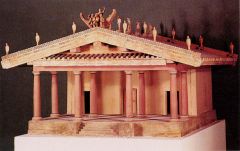
|
|
|
Human Head Urn, Etruscan, 650 BCE
Urns often put on throne bases, shows that the people put in these urns had some sort of status in society face not lively, body is abstract not really specific portraits, but shows that afterlife is important to them |
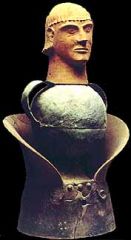
|
|
|
Fibula with Lions, Etruscan, 650 BCE
gold pin, rich family, has oriental lions on it, influences from the east and from Mesopotamia |
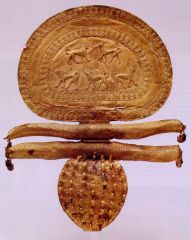
|
|
|
Mirror Back, Etruscan, 400 BCE
front would have been super polished bronze, figure with wings on back, reading fortunes with a liver border is very busy vine motif, wings curve with shape, foreground and background clear, |
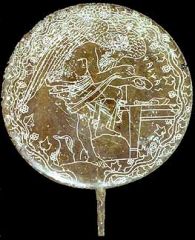
|
|
|
Ficoroni Cista, 375 BCE, Etruscan
container for women's toiletries, bronze, with feet popular gifts for living and dead Shows a greek story on the frieze on top made in rome, rising power there at the time |
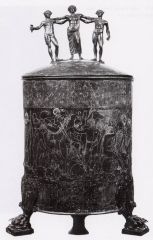
|
|
|
Porta Marzia, 150 BCE, Etruscan
sign of peace between an Etruscan group and growing rome has pilaster columns, adaptation on greek style, precursor to future Roman Arches |

|
|
|
Sarcophagus with Reclining Couple, Etruscan, 500 BCE
really was an urn in a sarcophagus shape, only for man, because he is depicted as relaxing, reclining shows that they think of afterlife as space to relax, have fun, probably at a banquet, no sadness in death little focus on form, body/legs are contorted |
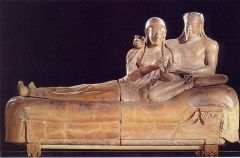
|
|
|
Sarcophagus of Lars Pulena, Etruscan, 200 BCE
on a couch, with pictures of the underworld beneath him, he has made the journey to the afterlife not as happy as earlier ones, though he is relaxing, no wife or banquet, more serious expression, goes along with struggles at the time, end of etruscan rule but still proud with his fillet and wreath scroll |
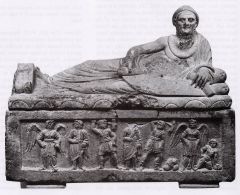
|
|
|
Sarcophagus of A Youth, Etruscan, 400 BCE
urn in form of sarcophagus, two figures, one a youth, the other an angel guiding him to afterlife no long an everyday scene, more divine he's reaching for her scroll, acceptance to afterlife Etruscan starting to break down, more Greek and Roman influences, more holistic, supernatural view of afterlife, more focus on divine beings |
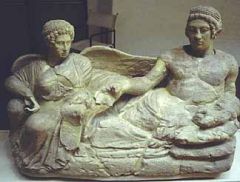
|
|
|
Tomb of Reliefs, Etruscan, 250 BCE,
everyday view of afterlife, tomb filled with everyday utensils, decorated to look like a house, shows that life goes on, but also spiritual side because the guide to the underworld is there. |

|
|
|
Two Dancers, Etruscan, 400 BCE
on a tomolus tomb, light and dark skin= female vs male both very muscular, full of movement, less anatomically correct than greeks were, weird stuff around the hips, more focused on narrative/scene celebration of afterlife |
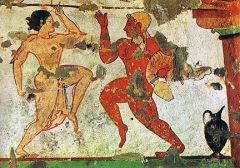
|

